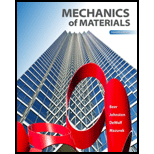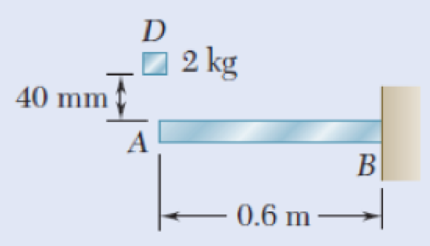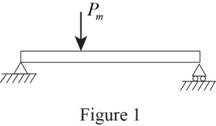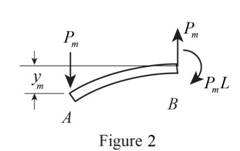
Concept explainers
A block of weight W is dropped from a height h onto the horizontal beam AB and hits point D. (a) Denoting by ym the exact value of the maximum deflection at D and by y’m the value obtained by neglecting the effect of this deflection on the change in potential energy of the block, show that the absolute value of the relative error is (y’m — ym)/ym, never exceeding y’m /2h. (b) Check the result obtained in part a by solving part a of Prob. 11.52 without taking ym into account when determining the change in potential energy of the load, and comparing the answer obtained in this way with the exact answer to that problem.
11.52 The 2-kg block D is dropped from the position shown onto the end of a 16-mm-diameter rod. Knowing that E = 200 GPa, determine (a) the maximum deflection of end A, (b) the maximum bending moment in the rod, (c) the maximum normal stress in the rod.

Fig. P11.52
(a)
The absolute value of the relative error
Answer to Problem 57P
The absolute value of the relative error
Explanation of Solution
Calculation:
Sketch the loading diagram as shown in Figure 1.

Refer to Figure 1.
Apply the spring constant k for the load applied at point D.
The load
Calculate the maximum strain energy
Substitute
Calculate the work of the block exactly as shown below.
Calculate the work of the block approximately as shown below.
Equating work and strain energy as shown below.
Equating work and strain energy exactly as shown below
Substitute
Equating work and strain energy exactly as shown below
Substitute
Here,
Subtracting Equation (3) from Equation (2) as shown below.
Here,
Substitute
Hence, the absolute value of the relative error
(b)
The relative error of the block.
Answer to Problem 57P
The relative error of the block is
Explanation of Solution
Given information:
The mass of the block is
The modulus of elasticity is
The diameter of the rod is
The length of the beam is
The dropping height is
Calculation:
Refer to part (a).
The relative error is
Consider the acceleration due to gravity as
Calculate the weight of the block as shown below.
Substitute
Calculate the moment of inertia
Substitute
Calculate the moment of inertia
Substitute
Calculate the centroid (c) of the rod as shown below.
Substitute
Sketch the deformation diagram as shown in Figure 2.

Refer to Figure 2.
Refer to Appendix D “Beam Deflections and Slope” in the text book,
Calculate the maximum deflection
Substitute
Calculate the maximum strain energy
Substitute
Calculate the work of the block as shown below.
Substitute
Calculate the maximum deflection
Substitute
Calculate the spring constant
Substitute
Calculate the approximate value of
Substitute
Calculate the relative error as shown below.
Substitute
To check:
Therefore, the relative error is
Want to see more full solutions like this?
Chapter 11 Solutions
Mechanics of Materials, 7th Edition
- PROBLEM 3.46 The solid cylindrical rod BC of length L = 600 mm is attached to the rigid lever AB of length a = 380 mm and to the support at C. When a 500 N force P is applied at A, design specifications require that the displacement of A not exceed 25 mm when a 500 N force P is applied at A For the material indicated determine the required diameter of the rod. Aluminium: Tall = 65 MPa, G = 27 GPa. Aarrow_forwardFind the equivalent mass of the rocker arm assembly with respect to the x coordinate. k₁ mi m2 k₁arrow_forward2. Figure below shows a U-tube manometer open at both ends and containing a column of liquid mercury of length l and specific weight y. Considering a small displacement x of the manometer meniscus from its equilibrium position (or datum), determine the equivalent spring constant associated with the restoring force. Datum Area, Aarrow_forward
- 1. The consequences of a head-on collision of two automobiles can be studied by considering the impact of the automobile on a barrier, as shown in figure below. Construct a mathematical model (i.e., draw the diagram) by considering the masses of the automobile body, engine, transmission, and suspension and the elasticity of the bumpers, radiator, sheet metal body, driveline, and engine mounts.arrow_forward3.) 15.40 – Collar B moves up at constant velocity vB = 1.5 m/s. Rod AB has length = 1.2 m. The incline is at angle = 25°. Compute an expression for the angular velocity of rod AB, ė and the velocity of end A of the rod (✓✓) as a function of v₂,1,0,0. Then compute numerical answers for ȧ & y_ with 0 = 50°.arrow_forward2.) 15.12 The assembly shown consists of the straight rod ABC which passes through and is welded to the grectangular plate DEFH. The assembly rotates about the axis AC with a constant angular velocity of 9 rad/s. Knowing that the motion when viewed from C is counterclockwise, determine the velocity and acceleration of corner F.arrow_forward
 Elements Of ElectromagneticsMechanical EngineeringISBN:9780190698614Author:Sadiku, Matthew N. O.Publisher:Oxford University Press
Elements Of ElectromagneticsMechanical EngineeringISBN:9780190698614Author:Sadiku, Matthew N. O.Publisher:Oxford University Press Mechanics of Materials (10th Edition)Mechanical EngineeringISBN:9780134319650Author:Russell C. HibbelerPublisher:PEARSON
Mechanics of Materials (10th Edition)Mechanical EngineeringISBN:9780134319650Author:Russell C. HibbelerPublisher:PEARSON Thermodynamics: An Engineering ApproachMechanical EngineeringISBN:9781259822674Author:Yunus A. Cengel Dr., Michael A. BolesPublisher:McGraw-Hill Education
Thermodynamics: An Engineering ApproachMechanical EngineeringISBN:9781259822674Author:Yunus A. Cengel Dr., Michael A. BolesPublisher:McGraw-Hill Education Control Systems EngineeringMechanical EngineeringISBN:9781118170519Author:Norman S. NisePublisher:WILEY
Control Systems EngineeringMechanical EngineeringISBN:9781118170519Author:Norman S. NisePublisher:WILEY Mechanics of Materials (MindTap Course List)Mechanical EngineeringISBN:9781337093347Author:Barry J. Goodno, James M. GerePublisher:Cengage Learning
Mechanics of Materials (MindTap Course List)Mechanical EngineeringISBN:9781337093347Author:Barry J. Goodno, James M. GerePublisher:Cengage Learning Engineering Mechanics: StaticsMechanical EngineeringISBN:9781118807330Author:James L. Meriam, L. G. Kraige, J. N. BoltonPublisher:WILEY
Engineering Mechanics: StaticsMechanical EngineeringISBN:9781118807330Author:James L. Meriam, L. G. Kraige, J. N. BoltonPublisher:WILEY





